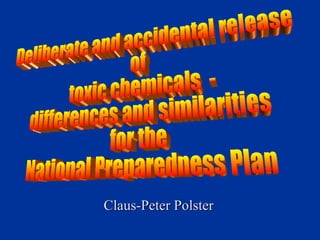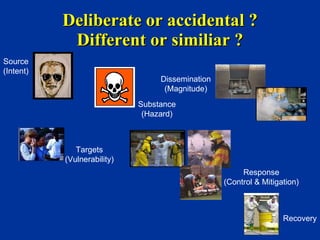Deliberate And Accidental Release of Toxic Chemicals
- 1. Claus-Peter Polster Deliberate and accidental release of toxic chemicals - differences and similarities for the National Preparedness Plan
- 2. Aim To understand the differences and similiarities between deliberate and accidental release of toxic chemicals To understand the consequences of these differences and similiarities for the Risk Management To know the typical contents of a National Preparedness Plan
- 3. Hazard Any potential or real condition which may cause injury/disease or death, damage or loss of property Definitions
- 4. Risk The probability (likelyhood) with which a catastrophic event may occur Multiplied with the severity of the outcome Definitions
- 5. Definitions Intent Group/Individual Motivation Organisation Opportunity Objective Capability Acquisition Development Testing Target selection Deployment Threat Type Character Magnitude
- 6. Vulnerability V Degree of loss to a given element at risk resulting from a given hazard at a given severity, also ŌĆ×resilienceŌĆ£ 1/V Definitions
- 7. Risk management Identification of the hazard Evaluation of the risk Risk decision Implementation of hazard controls Monitoring and evaluation of controls Response Mitigation of consequences Recovery Risk Management
- 8. Significant deliberate releases 1984 USA Salmonella -> 0 killed, thousands sick 1994 Japan Sarin -> 7 killed, 270 injured 1995 Japan Sarin -> 12 killed, 5000 injured* 2001 USA, Chile, Pakistan, Anthrax -> 5 killed, 35 cases Ōłæ ~ 25 killed, < 10.000 injured * Other sources ~ 200 injured
- 9. Significant conventional attacks 1983 Beirut, truck-bomb -> 242 killed, several injured 1985 Air India, bomb -> all 329 on board killed 1988 Pan Am 103, air plane bomb -> all 259 on board killed 1993 WTC, car bomb -> 6 killed, 1.000 injured 1995 Oklahoma City, truck bomb, 166 killed, hundreds injured 1996 Colombo, truck bomb -> 90 killed, 1.400 injured 1998 Nairobi, truck bomb -> 291 killed, 5.000 injured 2001 WTC, commercial airplane -> 3.500 killed, ?? Injured Ōłæ 4.500 killed, 8.000 injured
- 10. Significant industrial accidents 1976 Italy, Dioxine -> 0 killed immediately, > 2000 injured 1984 India, Methyl Isocyanate -> > 3.589 killed, 100.000 injured 1984 Mexico, Gas tank explosion -> 452 killed, 4.248 injured 1988 Pakistan, Munitions plant explosion -> 78 killed, 1.500 injured 1992 Mexico, Sewer explosion -> 22 killed, 1.600 injured 2000 Netherlands, Fireworks explosion -> 22 killed, 944 injured Ōłæ > 4.000 killed, > 100.000 injured
- 11. FACTS database About 19.000 accidents with hazardous materials worldwide 1.700 natural gas 650 ammonia 850 chlorine 1.850 LPG 1.850 road transport 1.000 rail transport 4.500 environmental damage 5.600 human error 305 sabotage 11 during Navigation (crude oil) 67 with Pipeline (crude oil, petrol, natural gas) 17 during Production / Processing 12 during Rail transport 12 during Road transport 118 during Storage 61 during Use / Application
- 12. ╠²
- 13. ╠²
- 14. ╠²
- 15. Deliberate or accidental ? Different or similiar ? Source (Intent) Substance (Hazard) Dissemination (Magnitude) Response (Control & Mitigation) Targets (Vulnerability) Recovery
- 16. Recovery Decontamination of contaminated soil, infrastructure, buildings Rebuilding of destroyed structures Decontamination of groundwater Toxic waste disposal Recovery from non-tangible losses Recovery of the environment
- 17. Targets vulnerability Structural resistance of buildings Tight windows, doors etc. Population density Sociologic structure (children, elderly) Education Poverty Access to medical services Access to information Malnutrition Pre-conditions The poorest are always hit the worst!
- 18. Response Identical for deliberate acts and major accidents Substances may differ The ŌĆ×Second DeviceŌĆ£ Spread-out pattern may differ Medical services will be the focus For accidents more information may be available
- 19. Dissemination Industrial Leaks Bursts, explosions Spills Mostly static CBW Food, other commodities Breakable containers Crude sprayer devices Makeshift exploding devices Acquired military devices At will
- 20. Substance Receipes available @ WWW (?) Aum Shinruku spend > 1 Mio US $ for research Most devices did not work (including 9 attempts to use anthrax) Likely Cyanide Commercial pestcontrol substances ITOX, HAZMAT Rizin Sulfur Mustard Unlikely VX Amounts ? Availability ?
- 21. 1 10 20 100 200 Chlorine Cyanogen Chloride Phosgene Hydrogen Cyanide Mustard Sarin VX 600 RELATIVE LETHALITY IN RELATION TO CHLORINE (RESPIRATORY) 50ppm chlorine are potentially fatal even after short exposure 600x 200x 13x 7x 6x 2x
- 22. Source (Intent) Chemical production is overt , intentional release is covert ! Plant safety and security Transportation safety and security Rigorous controls of HAZMAT Information policy Preparedness of First Responders and Public Health System Co-ordination with Security, Intelligence, Police...
- 23. Chemical warfare without CW ? ŌĆ£ Gas is insidious. It often causes casualties without any warning. It exerts a tremendous effect on morale, especially in untrained troops. Uncertainty as to when and where gas is present and how it will act is demoralizing even to troops with high discipline. Nothing breaks a soldierŌĆÖs will to fight so quickly as being gassed, even slightly. His imagination magnifies his real injury 100-fold.ŌĆØ Frederic Brown Chemical Warfare: A Study in Restraints . Princeton, NJ: Princeton University Press; 1968
- 24. Fatalities Injuries Atropine overdose Anxiety 2 224 230 544 18 January - 28 February 1991 Iraqi SCUD attacks on Israel
- 25. Fatalities Hospitalized Ambulant ŌĆ£ Non-CasualtiesŌĆØ 4500 1000 12 200 20 March 1995
- 26. ╠²
- 27. Typical Contents of a National Preparedness Plan A policy statement Legislative authority Objectives and Conditions Assessment of the community disaster risks Disaster scenarios Based on past experiences and present risks
- 28. Typical Contents of a National Preparedness Plan Roles and relationship within the government levels National, regional, local and inter-agency Organization chart of lines of authority List of names, adresses, telephone and fax numbers, email adresses of all relevant agencies and their heads and deputies
- 29. Typical Contents of a National Preparedness Plan Operations of warning systems Preparedness preparations Agencies roles Emergency evacuation procedures Search and rescue Shelters Medical facilities etc., etc.
- 30. Typical Contents of a National Preparedness Plan Communications arrangements and telecommunications equipment and procedures Public information programme Recovery and reconstruction resources and mechanisms Disaster assessment plan
- 31. Agreements and linkages with other regions, countries and international organisations Testing and evaluation of the plan Revision and distribution of the plan Source: UN Disaster Management Training Programme Typical Contents of a National Preparedness Plan
- 32. Conclusions There are differences in deliberate and accidental release The practical differences for prevention and response are only minor, however, the political impact is far more severe Preparedness for accidents is preparedness for malevolent acts The broader the coverage, the better the chances for prevention National Preparedness and Response Plans need to cover all potential disaster types
- 33. Questions ?
Editor's Notes
- #20: Bad M├╝nder 09/09/02 Epichlorhydrin 350 people medically treated
































